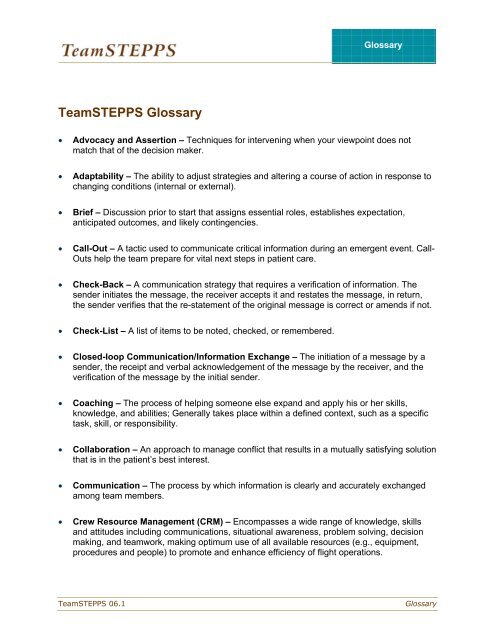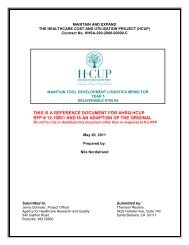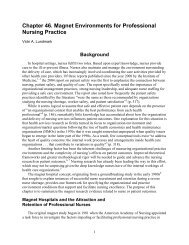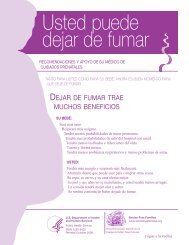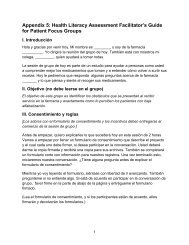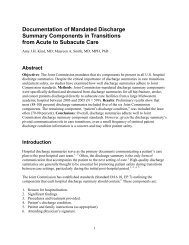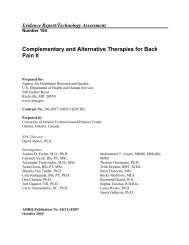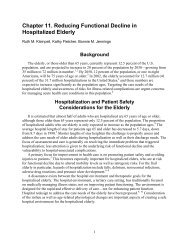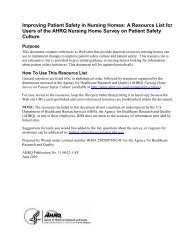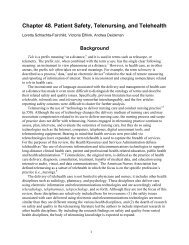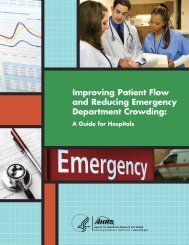TeamSTEPPS Glossary
TeamSTEPPS Glossary
TeamSTEPPS Glossary
You also want an ePaper? Increase the reach of your titles
YUMPU automatically turns print PDFs into web optimized ePapers that Google loves.
<strong>Glossary</strong><br />
<strong>TeamSTEPPS</strong> <strong>Glossary</strong><br />
• Advocacy and Assertion – Techniques for intervening when your viewpoint does not<br />
match that of the decision maker.<br />
• Adaptability – The ability to adjust strategies and altering a course of action in response to<br />
changing conditions (internal or external).<br />
• Brief – Discussion prior to start that assigns essential roles, establishes expectation,<br />
anticipated outcomes, and likely contingencies.<br />
• Call-Out – A tactic used to communicate critical information during an emergent event. Call-<br />
Outs help the team prepare for vital next steps in patient care.<br />
• Check-Back – A communication strategy that requires a verification of information. The<br />
sender initiates the message, the receiver accepts it and restates the message, in return,<br />
the sender verifies that the re-statement of the original message is correct or amends if not.<br />
• Check-List – A list of items to be noted, checked, or remembered.<br />
• Closed-loop Communication/Information Exchange – The initiation of a message by a<br />
sender, the receipt and verbal acknowledgement of the message by the receiver, and the<br />
verification of the message by the initial sender.<br />
• Coaching – The process of helping someone else expand and apply his or her skills,<br />
knowledge, and abilities; Generally takes place within a defined context, such as a specific<br />
task, skill, or responsibility.<br />
• Collaboration – An approach to manage conflict that results in a mutually satisfying solution<br />
that is in the patient’s best interest.<br />
• Communication – The process by which information is clearly and accurately exchanged<br />
among team members.<br />
• Crew Resource Management (CRM) – Encompasses a wide range of knowledge, skills<br />
and attitudes including communications, situational awareness, problem solving, decision<br />
making, and teamwork, making optimum use of all available resources (e.g., equipment,<br />
procedures and people) to promote and enhance efficiency of flight operations.<br />
<strong>TeamSTEPPS</strong> 06.1<br />
<strong>Glossary</strong>
<strong>Glossary</strong><br />
• Cross Monitoring – The process of monitoring other team member’s actions against the<br />
standard or shared plan of care for the purpose of sharing workload and reducing or<br />
avoiding errors.<br />
• CUS – Signal phrases that denote “I am Concerned, I am Uncomfortable, This is a Safety<br />
Issue.” When spoken, all team members will understand clearly not only the issue, but the<br />
magnitude of the issue.<br />
• Debrief – Brief, informal information exchange session designed to improve team<br />
performance and effectiveness; after action review.<br />
• DESC Script – A technique for managing and resolving conflict.<br />
• Feedback – The transmission of evaluative or corrective information.<br />
• Handoff – The transfer of information/knowledge along with authority and responsibility<br />
among care providers at all levels of care transitions and across the continuum of care.<br />
• Huddle – Ad hoc planning to re-establish Situation Awareness; designed to reinforce plans<br />
already in place, and assess the need to adjust the plan.<br />
• Human Factors – Human capabilities and limitations to the design and organization of the<br />
work environment. Primarily attributed to errors, but also a consideration in the design of<br />
workflow and processes. The study of human factors can help identify operations<br />
susceptible to human error and improve working conditions to reduce fatigue and<br />
inattention.<br />
• I PASS THE BATON – a mnemonic used during handoffs to facilitate a structured transition<br />
in care.<br />
• I’M SAFE Checklist – A simple checklist that should be used daily to determine both your<br />
coworkers’ and your own ability to perform safely.<br />
• Leadership – The ability to coordinate the activities of team members and teams by<br />
managing the resources available to team members and facilitating team performance by<br />
communicating plans, providing information about team performance through debriefs; and<br />
providing support to team members when needed.<br />
• Mutual Support – The ability to assess and anticipate other team member’s needs through<br />
accurate knowledge about their responsibilities, task load and core capabilities and in<br />
response to shift workload among members to achieve balance during high or low periods of<br />
workload or pressure.<br />
<strong>Glossary</strong> <strong>TeamSTEPPS</strong> 06.1
<strong>Glossary</strong><br />
• Mutual Trust – The shared belief that team members will perform their roles and protect the<br />
interests of their teammates.<br />
• Obstacles – Human behaviors that result from both personality and attitude which prevent<br />
effective job performance. Obstacles are ever present, requiring vigilant awareness to<br />
overcome them. Some examples of obstacles include:<br />
– Excessive Professional Courtesy – giving someone of higher rank or status too much<br />
respect or deference so that it affects the level of health care they receive. May also<br />
occur among team members having higher rank or status, resulting in a hesitancy of<br />
team members to point out deficiencies in performance.<br />
– Halo Effect – occurs when someone else’s “great” reputation or extensive experience<br />
clouds our judgment.<br />
– Passenger Syndrome – Team members experience “Passenger Syndrome” (“just<br />
along for the ride”) when they abdicate responsibility believing someone else is in<br />
charge.<br />
– Hidden Agenda – When a team member makes suggestions or decisions on<br />
information or desires of which the rest of the team may be unaware. An example of<br />
hidden agenda is a strong desire to get off work early or avoid a procedure in which they<br />
are poorly trained.<br />
– Complacency – When individuals and/or teams become comfortable with the most<br />
routine to the most difficult or critical tasks. Becomes a hazard when individuals and<br />
teams lose their vigilance and situational awareness.<br />
– High-Risk Phase – a procedure or time in which a medical mishap is likely to happen<br />
(e.g., shift change).<br />
– Task (Target) Fixation – a condition in which an individual’s and/or team’s focus on a<br />
task may impair their decision-making or make them oblivious to “the big picture”. It is<br />
generally precipitated by a real or perceived pressure to perform, or by workload/stress<br />
related issues.<br />
– Strength of an Idea – an unconscious attempt to make available evidence fit a<br />
preconceived situation. Once a person gets a certain idea in their head, it can be difficult<br />
or impossible for them to alter that idea no matter how much conflicting information is<br />
received.<br />
– Hazardous Attitudes – ways of thinking and viewing the world (e.g., anti-authority,<br />
impulsiveness, invulnerability, machismo or resignation).<br />
<strong>TeamSTEPPS</strong> 06.1<br />
<strong>Glossary</strong>
<strong>Glossary</strong><br />
• Patient Care Team – Comprised of the patient, caregivers, and all staff within the<br />
healthcare delivery system.<br />
• Performance Monitoring – The ability of team members to monitor each other’s task<br />
execution and give feedback during task execution.<br />
• SBAR – A framework for team members to structure information when communicating to<br />
one another. (Physician to Physician, Nurse to Physician, Nurse to Nurse, Nurse to Staff,<br />
Nurse to Patient).<br />
• Shared Mental Model – An organizing knowledge structure of relevant facts and<br />
relationships about a task or situation that are commonly held by members of a team.<br />
• Situation Awareness – The ability to identify, process, and comprehend the critical<br />
elements of information about what is happening to the team with regards to the mission<br />
(plan of care). Simply, it’s knowing ‘What’s going on around you’ and ‘what is likely to<br />
happen next’; – maintaining mindfulness at all times.<br />
• Situation Monitoring – The process of actively scanning and assessing elements of the<br />
situation to gain information or maintain an accurate awareness or understanding of the<br />
situation in which the team functions.<br />
• STEP – A tool for monitoring the following elements of the situation: Status of the patient,<br />
Team members, Environment, and Progress toward the goal.<br />
• Task Assistance – A form of mutual support, this team behavior protects individual<br />
members from work overload situations that may reduce effectiveness and increase the risk<br />
of error.<br />
• Team (Multi-Team System) – Each team within a multi-team system is responsible for<br />
various aspects of patient care, requiring coordination amongst them all to ensure quality<br />
patient care. A multi-team system is composed of the following teams:<br />
– Core Team – A group of caregivers who work interdependently to manage a set of<br />
assigned patients from point of assessment to disposition.<br />
– Coordinating Team – Members of a department/unit responsible for managing the<br />
operational environment that supports the Core Team.<br />
– Contingency Team – A time-limited team formed for emergent or specific events and<br />
composed of members from various teams.<br />
– Ancillary Services – Primarily a service delivery team whose mission is to support the<br />
core team (e.g., lab, pharmacy).<br />
– Support Services – Primarily a service-focused team whose mission is to create<br />
efficient, safe, comfortable and clean healthcare environments (e.g., housekeeping).<br />
<strong>Glossary</strong> <strong>TeamSTEPPS</strong> 06.1
<strong>Glossary</strong><br />
– Administration – Includes executive leadership of a unit or facility. They have overall<br />
responsibility and accountability for the organization. They create the climate and culture<br />
in which a teamwork system functions.<br />
• Team Competencies – The attributes team members need to perform successfully as a<br />
team. The three types of competencies that are critical for effective teamwork include:<br />
– Team Knowledge Competencies – The principles and concepts that underlie a team’s<br />
effective task performance. To function effectively in a team, team members should<br />
know what team skills are required, when particular team behaviors are appropriate, and<br />
how to manifest these skills and behaviors in a team setting. Team members should also<br />
know the team’s mission and goals and be aware of one another’s roles and<br />
responsibilities in achieving them.<br />
– Team Skill Competencies – A learned capacity to interact with other team members at<br />
some minimal proficiency.<br />
– Team Attitude Competencies – Internal states that influence a team member’s choices<br />
or decisions to act in a particular way. Positive attitudes toward teamwork, a collective<br />
orientation, and mutual trust among team members are critical to successful team<br />
process.<br />
• Team Orientation – The propensity to take other’s behavior into account during group<br />
interaction and the belief in the importance of team goal’s over individual member’s goals.<br />
• Team Self Correction – The process in which team members engage in evaluating their<br />
performance and in determining the strategies after task execution.<br />
• Team Structure – The delineation of fundamentals (e.g., team size, team membership,<br />
team leadership, team identification, and team distribution).<br />
• Two-Challenge Rule – A strategy for asserting a concern that results when clinical actions<br />
or a course of care differ from the agreed up plan or usual procedure for the presenting<br />
event. To carry out the Two-Challenge involves asserting the concern at least two times to<br />
ensure that it has been heard i.e., state the concern (first challenge), and if no response or<br />
discussion occurs, rephrase and restate the concern (second challenge) to be certain the<br />
challenge has been both heard and understood.<br />
<strong>TeamSTEPPS</strong> 06.1<br />
<strong>Glossary</strong>


